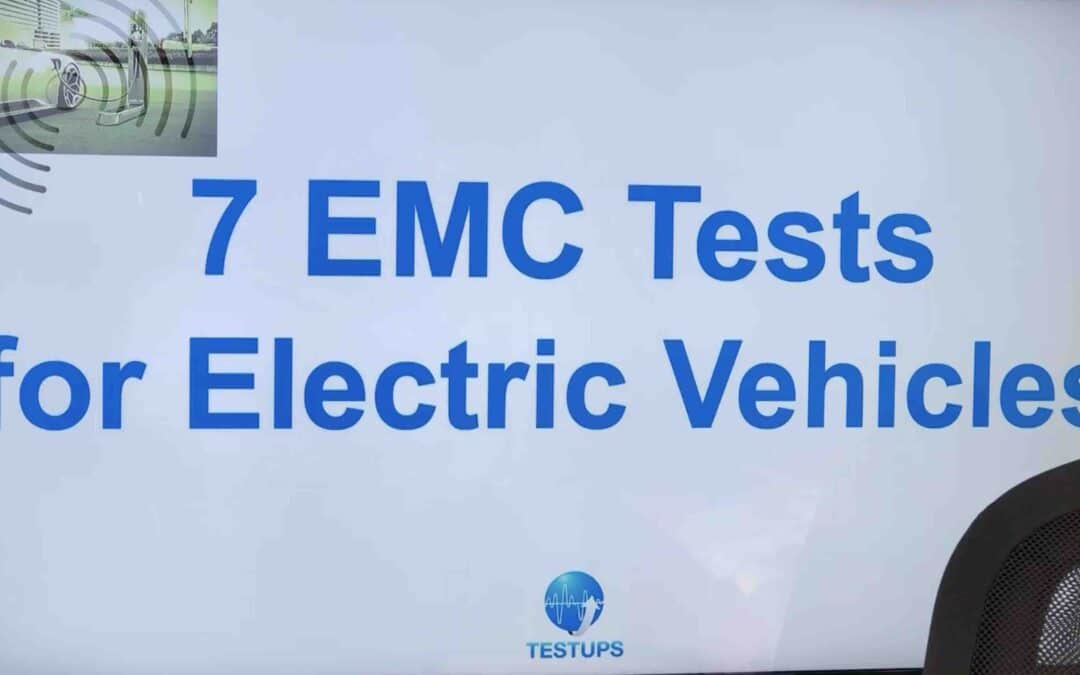7 EMC Tests for Electric Vehicles
On this post, we are listing the seven electromagnetic compatibility (EMC) tests applicable for electric vehicles. Our reference regulation is United Nation’s ECE Regulation 10 which covers more than 50 countries in the World.
- Radiated Emissions
- Radiated Immunity
- Conducted Emissions
- Harmonics Emissions
- Flicker Emissions
- EFT/Burst Immunity
- Surge Immunity
Each test is performed according to relevant annex of ECE R10 and referred EMC test standard. Basic parameters of each test is given below:
- Radiated Emissions (30 MHz – 1 GHz)
- Radiated Immunity (20 MHz – 2 GHz)
- Conducted Emissions (150 kHz – 30 MHz)
- Harmonics Emissions (AC power lines)
- Flicker Emissions (AC power lines)
- EFT/Burst Immunity (±2 kV on AC/DC lines)
- Surge Immunity (±2 kV on AC, 0.5kV on DC lines)
Test frequencies, limits and levels may change in time. Above parameters reflects the current version of the regulation (ECE R10, Revision 6)
Let us focus on each test and explain the test parameters in detail:
1) Radiated Emissions (30 MHz – 1 GHz)
For which vehicles? Radiated Emissions tests are performed all vehicle types under the scope of ECE R10. Regardless of source of energy (electricity or oil), RF emissions are limited by the regulation.
There is two types of radiated emissions tests under UN ECE R10:
Broadband: This type of radiated emissions tests are performed with Peak and Quasi-Peak detectors
Narrowband: This type of radiated emissions tests are performed with Average detector
Measurement distance (the distance between measuring antenna and Vehicle Under Test) is either 3 meters or 10 meters.
Required Test Site: ALSE or OTS
Required Test Equipments: EMI Receiver (with QP, AV, P detectors, frequency range: 30-1000MHz, RBW: 100/120kHz), Biconical and Log-Periodic Antennas, Antenna Tripod, LISN/AMN, Artificial Network (AN), Asymmetric Artificial Network (AAN)
Measurement frequency: 30 MHz to 1000 MHz
Reference test standards: CISPR 12 and CISPR 25
Below figure shows an example test setup which is given on ECE R10 (Rev.6):


2) Radiated Immunity (20 MHz – 2 GHz)
For which vehicles? Radiated Immunity tests are performed for the vehicles which have immunity related functions. Immunity related functions are defined by the regulation. Most of the vehicles has immunity related functions and are subjected to these radiated immunity tests.
The engine shall normally turn the driving wheels at a steady speed of 50 km/h if there is no technical reason due to the vehicle to define a different condition. For vehicles of categories L1 and L2 the steady speed shall normally be turned at 25 km/h. The vehicle shall be on an appropriately loaded dynamometer or alternatively supported on insulated axle stands with minimum ground clearance if no dynamometer is available. Where appropriate, transmission shafts, belts or chains may be disconnected (e.g. trucks, two- and three-wheel vehicles).
Frequency range: 20MHz to 2000MHz
The vehicle is subject to electromagnetic fields and monitored during the tests. For radiated immunity tests ECE R10 mentions two test types for vehicles:
*Free field testing according to ISO 11451-2
This test method is the recommended method. It requires field generating device, and the field generating device can be either antenna or transmission line system- TLS.
25 V/m, 20MHz-2GHz
Measurement distance (the distance between the antenna and Vehicle Under Test) is less then 2 meters.
Required Test Site: ALSE or OTS for free field testing method
Required Test Equipments: RF Signal Generator, RF Amplifier, Test Software, RF Probe, RF Cable, Artificial Networks (ANs), DC-charging ANs, AANs, Power Charging Harness, Charging Station / Power Mains
Reference test standards: ISO 11452-2, ISO 11451-1
*Bulk current injection (BCI) testing method according to ISO 11451-4
This test method is only applied for specific vehicles. If a vehicle is longer than 12 m and/or wider than 2.60 m and/or higher than 4.00 m, BCI (bulk current injection) method according to ISO 11451-4 shall be used in the frequency range 20 to 2,000 MHz with a 60 mA rms BCI level.
However, the applicable frequency range for BCI test method is 1-400 MHz according to ISO 11451-4. Thus applying BCI test is not possible outside this frequency range.
BCI testing method requires current injection probe(s) and current measurement probe(s) test requires. The vehicle is tested as built, no additional grounding connection is allowed. The distance between the vehicle and all other conductive structures shall be at least 50 cm. Walls of shielded room shall be minimum 50 cm away from the vehicle. The only exception is the ground floor of the shielded room.
Required Test Site: Shielded Room for BCI test method
Required Test Equipments: Current Injection Probe, RF Generator, RF Amplifier, Test Software, Current Measurement Probe, RF Cable
Reference test standards: ISO 11452-4, ISO 11451-1
Below figure (on Annex 6 of ECE R10, Rev.6) shows an example test setup. As seen below not all setup details are given and you should also follow the ISO 11452-2 or ISO 11452-4 standards.

3) Conducted Emissions (150kHz – 30 MHz)
Conducted Emissions tests are only performed on electric vehicles, not on non-electrical vehicles. RF emissions on power lines and network lines are measured via LISN/AMN.
Required Test Equipments: EMI Receiver (with QP, AV, P detectors), LISN/AMN
Measurement frequency: 150 kHz to 30 MHz
Reference test standards: CISPR 25

4) Harmonics Emissions
Harmonics Emissions tests are only performed for electric vehicles. Harmonics on AC power lines are measured and compared with the limits.
Required Test Equipments: Harmonics Analyzer or Power Analyzer (maximum current of these instruments shall be able to operate the vehicle at maximum current)
Measurement frequency: 50 Hz to 2000 Hz
Reference test standards: IEC 61000 3-2, IEC 61000 3-12

5) Flicker Emissions
Flicker Emissions tests are only performed for electric vehicles. Flicker on AC power lines are measured and compared with the limits.
Required Test Equipments: Flicker Analyzer or Power Analyzer and Power Source (maximum current of these instruments shall be able to operate the vehicle at maximum current)
Reference test standards: IEC 61000 3-3, IEC 61000 3-11
6) EFT/Burst Immunity
EFT/Burst Immunity tests are only performed for electric vehicles. EFT/Burst signal is subjected to vehicle via CDN.
Required Test Equipments: EFT/Burst Generator and CDN (maximum current of these instruments shall be able to operate the vehicle at maximum current)
Test levels: ±2 kV on AC/DC lines
Reference test standards: IEC 61000 4-4
Performance of the vehicle is monitored during the test and performance criteria will be used to make conformity assessment (Pass/Fail evaluation)

7) Surge Immunity
Surge Immunity tests are only performed for electric vehicles. Surge signal is subjected to vehicle via CDN.
Required Test Equipments: Surge Generator and CDN (maximum current of these instruments shall be able to operate the vehicle at maximum current)
Test levels: ±2 kV on AC lines, ±0.5 kV on DC lines
Reference test standards: IEC 61000 4-5
Performance of the vehicle is monitored during the test and performance criteria will be used to make conformity assessment (Pass/Fail evaluation)
Do you need any EMC product or service for testing vehicles or electronic components?

We are offering broad range of services and products for Electromagnetic Compatibility (EMC) for automotive and other industries. Send us your requirements and ask a quotation.

Recent Comments